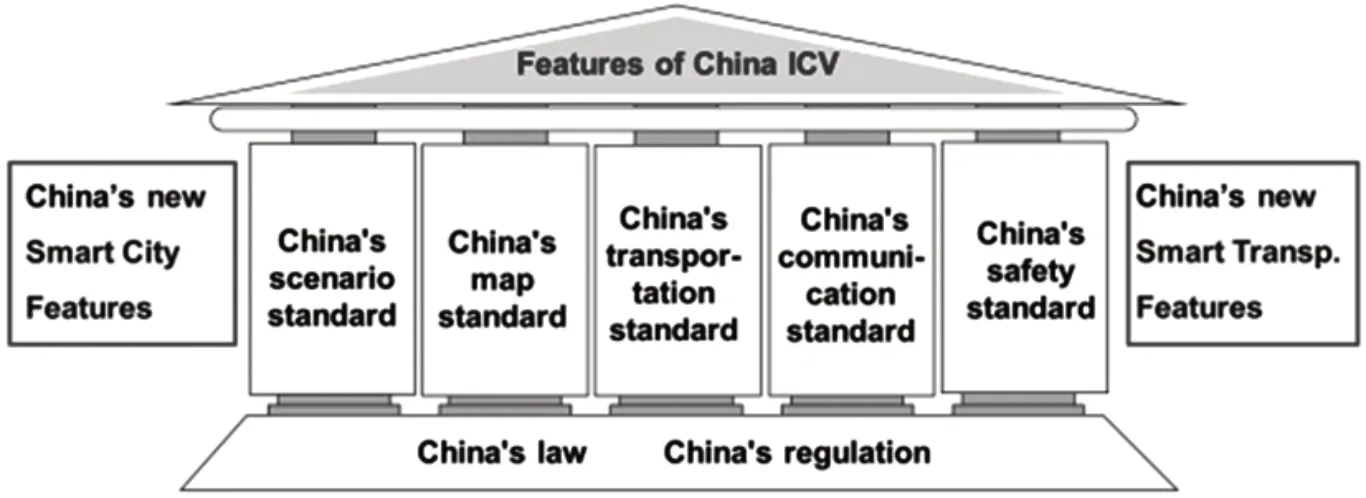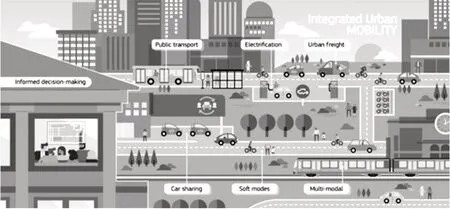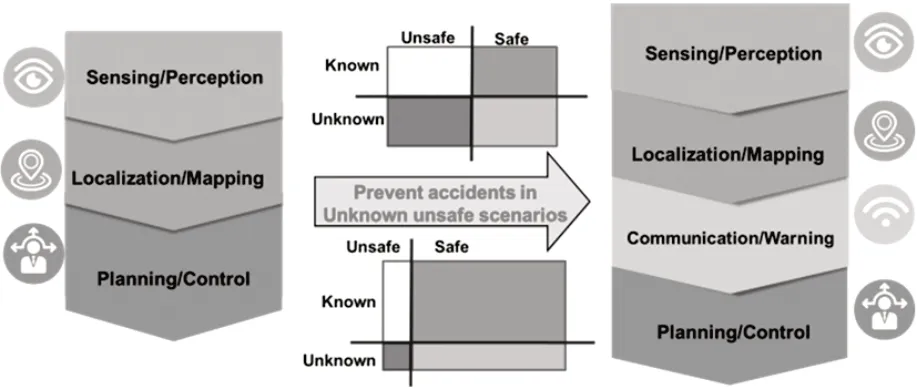中国智慧城市、智慧交通和智能汽车(SCSTSV)
——发展战略、系统构架和应用
2021-03-04李骏王永军
李骏 王永军
(1.清华大学 车辆与运载学院,北京 100083;2.中国第一汽车股份有限公司 创新技术研究院,汽车振动噪声与安全控制综合技术国家重点实验室,长春 130013)
主题词:智能网联汽车(ICV) 智慧城市 智慧交通
1 INTRODUCTION
Chinese automotive industry continues to grow and has been the largest automotive market in the world since 2009. It is predicted that numbers of vehicles sold across mainland China will be over 26.3 million units in 2021,as 25.2 million units are produced, and 25.3 million units[1]are sold in 2020.
According to statistics of The Ministry of Public Security of the P.R. China, Car population has reached 187 million units[2], numbers of cars per 1000 persons are 150[3], which is only 25% of average level of 600 in the developed countries.In the meantime,China has been facing enormous pressures both from environmental and social perspectives. With the ever increased amount of cars [2] and huge population, automobile-related issues encountered in China’s social development are traffic accidents, traffic congestion and difficulties in parking.According to statistics, the number of traffic accidents has been higher in the last 5 years [4], motor vehicle related crash occurred 620 times in 2018, with casualties[2].
In 2015, average travel time is prolonged more than 1.5 hours during rush hours according to the statistics of 43 cities in China [4]. In cities, 20 minutes (about 1/3 of total travel time) alone is needed for searching a parking lot [4]. On the other hand people are suffering from polluted air and environment where the ever increased huge car population is blamed for certain extent.
Economy and environment development in China are plagued by the traffic accidents [4] and related issues.68% of people on the earth will live in cities in 2050 according to the UN report [5], China’s urbanization will promote more people to live in cities.
To solve these problems, to end the traffic casualties and mitigate the influence on environment from the point of view of automotive sustainable development and perspectives, China’s auto industry needs to develop ICVs. The vision, mission and solution for China's ICV development will be included in four application scenarios.
The first application scenario is the mobility on express way. Development of smart and safe cars is crucial as our societies are facing the casualty losses of traffic, especially on express way, the vision of smart and safe car is to realize zero casualty in future. The most typical advanced technologies for smart and safe cars are the connectivity and intelligence based on AI, which is the ultimate solution to the issues on express way;
The second application scenario is the mobility in mega cities. A smart mobile car with the vision of being efficient and comfortable, is a must for the future mobility in mega cities in terms of being efficient and comfortable for both customers and infrastructures. The most typical concept is being connected and intelligent,to solve the problem of congestion in mega cities.
The third application scenario is shared mobility, or smart shared car,with its vision is“no need to own”.The most typical product is the connected, intelligent and driverless shared car, or Smart Vehicle which runs in Smart City with Smart Transportation system Vehicle(SCSTSV).
The fourth is“smart cloud management platform”.Its vision is to realize the“real-time management, realtime service.”
The concept of the China ICV Development Strategy is“to fully integrate international standards based on Chinese laws and formulate China’s national standards for scenarios, maps, transportation,communications and security(Fig.1).”
The connotations of China’s ICV development strategies are:“Based on China's new generation of smart cities and collaborative intelligent transportation systems,to achieve a deep integration of smart cities, intelligent transportation and smart cars.”
China’s new generation of smart cities and collaborative intelligent transportation systems have 10 important features respectively, as shown in Table 1.These features are beneficial to the development of China’s ICV.

Fig.1 Development Strategies for China’s ICV
The City Environment for the development of China ICV lies on a new generation of smart city architecture built in the future of China.
The integration of 6 important features of a new generation of smart cities in China and the in- depth integration of vehicles will create a mobility service platform for the new generation of smart cities, namely the "smart car cloud management platform". The resulting smart city environment will surely support vehicle intelligence progress in China. 6 important features include autonomous driving, cloud service, city infrastructure,mobility service,data center and connected life.
European Union has just released a new concept of smart city development with Integrated Urban Mobility,which is shown in the Fig. 2, in the Strategic Research Agenda on 23 March 2018 [6], the concept of Integrated Urban Mobility and Informed decision-making is very useful reference for China’s future smart city development.

Fig.2 Integrated Urban Mobility of EU in 2050[6]
The transportation environment for the development of China ICV is a new generation of intelligent traffic architecture in China. China’ s next- generation transportation architecture should be built as a 3- tier structure,with“ITS service layer,Infrastructure layer and Terminal layer”. Corresponding to these three layers,there are ITS Center Cloud (Center System Unit, CSU),Intelligent Traffic Edge Cloud (ESU), Wireless Access Network(4G/5G),plus Intelligent and Connected Vehiclemounted terminals,which will work together in a four-inone manner. Therefore the resulting Smart Transportation Environment is bound to strongly support the intelligentization of Chinese automobiles, which is shown in Fig.3.

Fig.3 China’s new generation ITS architecture
The integration of 10 key features of smart cities with automobiles (Table 1.) will result in a new generation of smart city mobility services.
EU recently announced efficient hybrid traffic control architecture, which includes Services Layer,Strategic Layer, Tactical Layer as well as Operational Layer [7].The four-in-one architecture is a reference for China’s future construction of a new generation of intelligent traffic architecture.
The development goal of China city ICV is to build a deep integration system in Smart City with Smart Traffic for Smart Vehicle (SCSTSV). The smart vehicle cloud service platform will be based on ubiquitous sensing,safe,efficient Internet and big data.Among them AI is the core of the deep integration of SCSTSV.
2 FUNCTIONAL SYSTEM OF CHINA SCSTSV
2.1 Challenges of China City ICV-L4
Chinese city ICV-L4 (Level 4), according to the definition of automated driving system of SAE International[8],must effectively solve the issues of safe,efficient mobility and intelligent sharing of ICV in complex urban scenes in China.
The urban ICV-L4 design faces 3 major challenges,which include the complex environmental perception,Safety Of The Intended Functionality(SOTIF)[9]as well as Responsibility-Sensitive Safety(RSS).
To meet these three challenges, one must start with the design criteria for establishing a computing platform for Chinese city ICV. Innovatively design of a special Functional System Architecture which is suitable for Chinese urban scenarios is a key issue, i.e. the Functional System Architecture of China SCSTSV.

Table 1. Features of Smart city and Smart Transportation
2.2 Design Principles and Innovative Solutions
2.2.1 Design Principle 1and Innovative Solution of Computing Platform for SCSTSV
(1)Design Principle 1
One of the design criteria for the SCSTSV computing platform is to use“urban data and sensing”to leanly and efficiently perceive urban traffic scenarios.China's smart cities are growing at a faster pace, with a wider spread, and the direction of development is urban digitization and sharing. In 2011, there were 99 smart cities in China, by 2017 it increased to 500, covering Beijing, Shanghai, Guangzhou, Chongqing and other big cities [10]. The development of smart cities in China is characterized by the establishment of urban big data centers, the implementation of cloud services, and the development of intelligent transportation systems.Promoting shared travel, these resources can be further improved and upgraded to serve urban ICVs, Therefore,the concept of“Urban Data and Sensing”is proposed to make full use of the real-time big data of smart cities and 5G&V2X, which conceives the SCSTSV computing platform to cope with the issue of complex urban environment perception and intelligent sharing travel problems.
(2)Innovative Solution
Based on the concept of“Urban data and sensing”,an innovative design is made for the in- vehicle computing platform controller architecture, which is shown on Fig. 4, where Smart City Sensors (SC) will provide dynamic real- time information, such as city travel and logistics decisions, city landmarks and maps,as well as urban resources(such as parking spaces),etc.
While the Smart Traffic Sensors (ST) will provide traffic sign information, traffic light information and remote traffic flow information,etc.
“Urban Data and Sensing”enhances the perception capabilities and comprehensive planning capabilities of the computing platform, and it can reduce the cost of smart car sensors. Developing the in-vehicle computing platform controller architecture,based on“urban data and sensing”, enables deep integration of smart cities, smart traffic and smart cars.

Fig.4 Innovative Solution 1——Architecture of In-Vehicle Computing Platform Controller using“Urban Data and Sensing”
2.2.2 Design Principle 2 and Innovative Solution of Computing Platform for SCSTSV.
(1)Design Principle 2
The second design criterion of the SCSTSV computing platform is to safely and reliably solve the safety issues of intended functionality,based on SOTIF.
Urban traffic scenarios are complex in China and there are a large number of unknown unsafe scenarios that are prone to occur, due to the expected automatic driving accidents caused by functional failure of SOTIF.It is not only necessary to make full use of“city data and sensing”, but also to shrink unknown unsafe scenarios area 3, which is shown on Fig. 5 [9], by a new special design of computing platform architecture.
(2)Innovative Solution
In accordance with the Design Principle 2 above,the second innovative solution is made for the SCSTSV computing platform. That is, the “communication/warning layer”which is added between the localization/mapping layer and the planning/control layer of the 3-layer architecture of current vehicle computing platforms shown in Fig. 6, which includes Sensing/Perception,Localization/Mapping and Planning/Control. The fourlayer architecture enables smart cars to communicate with other associated moving objects before implementing driving control, and issue warning information when necessary to reduce accidents in unknown unsafe scenarios.

Fig.5 Visualisation of the Known/Unknown Use Case categories[9]
2.2.3 Design Principle 3 and Innovation Solution of SCSTSV computing platform
(1)Design Principle 3
In Chinese cities, irregular driving behavior and disharmony are important reasons for the low traffic efficiency and frequent traffic accidents. Therefore, the design of the future SCSTSV computing platform must establish the third Design Principle of“harmony of driving behavior standards”.

Fig.6 Innovative solution 2 of SCSTSV computing platform design-add on communication early warning layer
The Responsibility Sensitive Safety(RSS) currently being discussed internationally is necessary to comply with the design of the SCSTSV computing platform, for example, RSS does not allow autopilot cars to make judgments and driving behaviors that lead to collisions;
RSS does not allow autonomous vehicles to avoid another accident by causing minor accidents.
RSS principle 1: Keeping the safe space, who violates,whose fault.
(a)If a rear car hits a front car, it’s always the rear car’s fault.
(b)If the front car performs a reckless cut into another car’s trajectory and the rear car then hits the front car from behind.In that case,it’s the front car’s fault.
RSS principle 2: To be careful with respect to situations where sight is limited.
(a)Calculate an assumption of the highest reasonable velocity.
(b)AV will not take a command that would put it at risk of causing a collision, even with an object that it can’t see.
(c)RSS will manage the AV’s speed so that it can always brake in time to avoid a collision with the pedestrian.
(2)Innovation solution
In order to achieve the Design Principle 3 above,models in the computing platform architecture of SCSTSV are introduced, shown in Fig. 7, where Intelligence quotient (IQ), Emotional quotient (EQ) and adverse situation quotient(AQ)are shown in Fig.7.

Fig.7 IQ,EQ,AQ models
Among them, EQ is related to the design Principle of“harmony of driving norms”. EQ is the ability to control emotions and behaviors for humans. For SCSTSV, it is an autonomous driving behavior, that conforms to rules and habits, does not disturb others, has clear intentions, in which the passenger feels fluent,smooth and swift.
2.3 SCSTSV computing platform architecture
Architecture of SCSTSV in- vehicle computing platform is established (Fig. 8), which is lean, efficient,safe and reliable, and adapts to the urban traffic scene in China.The architecture includes followings.

Fig.8 SCSTSV computing platform architecture
(1)The sensors: a city sensor, a traffic sensor, and a smart car sensor.
(2)The overall planning layer leading strategy, the local planning layer leading tactics, and the trajectory planning layer responsible for the response, Each layer has the ability to sense, locate, communicate early warning and planning, effectively reducing the occurrence of SOTIF.
(3)The ability design of IQ, EQ and adversity AQ ensures the harmony of driving behavior.
3 MARKET APPLICATION ANALYSIS FOR SCSTSV IN CHINA
3.1 Investigation in sharing mobility needs in China——Region,Subject and Trip Reason
Investigation in sharing mobility needs in China was conducted by cooperation of China-SAE with DiDi China in 2018. The investigated mega-cities included Beijing,Taiyuan, Qingdao, Shanghai, Hangzhou, Wuhan,Chengdu, Guangzhou and Shenzhen. The crowd in this investigation covered those born in 1969 and late,in their 70s、80s、90s and 00s. The investigation was conducted online with DiDi customers,
Investigation report defined the modes of sharing mobility, namely DiDi hitchhiking, Express, Premier,Taxi and car rental with short time and long time.
Mobility cause covers daily commuting, business trip and entertainment, etc. There are 3 important findings in this investigation report.
The 1st finding in the report is the reason why customers choose to travel by car sharing. The first 4 in the 11reasons are the main reasons for customers to choose shared mobility as followings:
●Time and energy saving without driving
●Flexible and convenience
●Cost
●No parking concern
The 2nd finding in this investigation shows the evolution of shared mobility in China cities as followings:
●From 2013 to 2017,mileage growth rate of shared mobility was increased from 1.4%to 18%.
●From 2013 to 2017, mileage growth rate of private car mobility was decreased from 20%to 3.8%.
The conclusion from above two findings is that sharing mobility already becomes a new life style:acceptance to sharing service increases day by day.
The 3rd finding in this investigation is that the Chinese customers demonstrated more willingness to accept New Energy Vehicle and Shared Mobility by ICV.The most customers in this investigation have expressed their more desires for technology application of AI and connected vehicles in the future mobility, which in turn requires more intelligent development for vehicles,transportation and smart city.
3.2 Pilot of China SCSTSV——Smart City&Smart Mobility System
Smart City & Smart Mobility System, in City of XiongAn, will be treated as pilot of China SCSTSV.XiongAn green transportation Eco-system is made up of Smart Sharing Mobility and Private Mobility. The percentage of Smart Sharing Mobility is set up much higher than Private Mobility, which will be realized by innovations in City ITS,City Space organization,AI Tech and ICV(Fig.9).
XiongAn Smart City & Smart Mobility System can be divided into 4 development directions:
●XiongAn modes,
●Xiongan Scenarios,
●XiongAn Technology
●XiongAn Roadmap.

Fig.9 XiongAn Green Transportation Eco-system
The development vision of Smart City & Smart Mobility System in XiongAn is
(1)To make great contributions to the Zero traffic accident,Zero traffic congestion,Zero Emission and Zero mobility difference between different vehicles.
(2) To make great contributions to the scientific and technological innovation, in the context of new generation of intelligent vehicles in China, independent innovation in the field will lead the scientific and technological innovation of intelligent driving in China and even in the world.
(3)To develop an integrated system of intelligent city, intelligent transportation and intelligent automobile through continuous innovation and improvement, so as to form a new model of people- oriented safe, clean,efficient, energy- saving and comfortable, intelligent,shared mobility ecology and benefit the people of Xiongan as well.
3.3 Future development of smart cities in China
Deloitte did deep research to the development of China's smart cities, the research report predicts the future of Chinese cities is to being developed in 6 directions, i.e. the smart economy, smart mobility, smart environment, smart safety, smart living, and smart education [10].The goal of smart mobility in China is to develop smart cities.
Shared mobility, autonomous driving, internet of things, and dynamic pricing make people and things move faster, safer, more economical and more environmentally friendly[10].
4 CONCLUSIONS
Automation will change urban life judging from the world trend, as EU released automated urban mobility vehicle development paths. Level 3 and level 4 highly automated urban mobility vehicles will be first on dedicated roads then in mixed traffic.
Global investment is focusing on sharing and autonomous solutions for future mobility, the future of global smart car related four areas are connectivity,automation, smart mobility and electrification, investment hotspots around world and China are focusing on autonomous and sharing solutions in the areas of autonomous and smart mobility.
The conclusions of this paper are as followings,
(1)The correct development strategy of China ICV is in deep integration with China’s new generation of smart cities and intelligent transportation.
(2)SCSTSV product design is a technological innovation, which are worth of being explored as design guidelines and system architecture.
(3)China’s development of smart cities provides a broad and promising market for SCSTSV products in future.
ACKNOWLEDGEMENT
Authors acknowledge the support from SAE-China for providing Shared vehicle mobility report.
